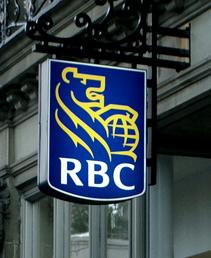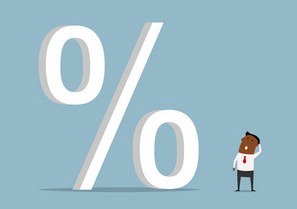In just the latest reminder that banks value profit above PR, each of the Big 5 have hiked prime rate by a full 1/4 point.
That means the rate variable mortgages are based on rises to 2.95% on Thursday, at most big lenders.
Some had speculated (hoped) that banks would lift prime just 15 bps to match their last stingy cut in 2015. But this was a “prime” opportunity for more yield and they weren’t going to let it go.
Consider that some banks have over $40 billion of variables on their books. That’s $40+ million bucks (a year) that they pocket by keeping prime inflated that extra one-tenth of a percentage point.
“This asymmetric response is [also] consistent with the desire of regulators to slow the growth in household debt,” said DLC Economist Sherry Cooper. Whoa. So there you have it. Banks are doing us a public service. We should be, umm, grateful?
Leading the Charge
 As is often the case, RBC was first out of the gate with its announcement at 12:31 p.m. ET Wednesday. It raised its trend-setting prime rate by 1/4 point and borrowers’ fates were thus sealed.
As is often the case, RBC was first out of the gate with its announcement at 12:31 p.m. ET Wednesday. It raised its trend-setting prime rate by 1/4 point and borrowers’ fates were thus sealed.
Then came TD, which, despite hiking 15 bps independently of the BoC last November, announced another full 25 bps increase today. TD’s “Mortgage Prime” is now 3.10% versus its peers’ 2.95%. Will existing TD floaters (variable-rate holders) vote with their wallets and flee at renewal? Most won’t, and TD knows that.
Meanwhile, TD is working hard to win over new buyers with the best variable refinance rate of any lender in Canada: 2.22% (as of Thursday).
The New Standards
The average variable rate in Canada is now prime – 0.58%. As of June 13 that’ll equate to 2.37%.
The typical HELOC rate in Canada is prime + 0.50%. That’s 3.45% as of June 13.
Locking in Late?
- For a new high-ratio purchase or switch: 2.29% to 2.39%
- For a new low-ratio purchase: 2.39% to 2.49%
- For a new conventional refinance: 2.39 to 2.69% (Check out HSBC’s 2.39% 5-year as they may pull it soon, but beware its IRD penalty if you break the mortgage before five years. It’s also capped at a 25-year amortization, a problem for the 1/2 of conventional borrowers who want an extended am. for lower payments.)
If you’re converting from a variable to a 5-year fixed, add at least 20 bps to these rates. Not only does conversion entail extra expense for the lender (such as securitization costs and other stuff you probably don’t care about), but lenders use their penalty as leverage against you. They know that most will pay a higher rate to avoid penalties and switching inconvenience.
It’s Not Just About Floaters
So far I’ve seen three analysts say that Wednesday’s hike only affects floating rate borrowers. Nothing could be further from the truth.
At least 80,000+ people a month renew their mortgage on average, according to data from Mortgage Professionals Canada. At least 7 in 10 of those renewers are coming from a fixed rate.
What the BoC has done is signal additional rate hikes. That’s driven up pricing on all terms, regardless of what term people have or are renewing into.
Now, don’t get me wrong. A quarter-point isn’t anything to blow an artery over. But tack on 2-4 more hikes and you’ll see a lot more borrowers reaching for their blood pressure pills.

 log in
log in

 So far I’ve seen three analysts say that Wednesday’s hike only affects floating rate borrowers. Nothing could be further from the truth.
So far I’ve seen three analysts say that Wednesday’s hike only affects floating rate borrowers. Nothing could be further from the truth.
6 Comments
What a surprise! The big banks pass down a portion of the rate cuts but 100% of the hikes. And as for TD, well it’s probably better if I don’t share my thoughts. Things are about to get a whole lot more expensive for a whole lot more people!
The banks used to set their prime rate at Bank of Canada Rate + 1.50% when. So when the Bank of Canada Rate was 3.00% Prime was 4.5%. At some point, they switched to BoC Rate + 2.0%. That is a 33% increase. The last two BoC Rate cuts of 0.25% the bank lowered prime 15 basis points, taking 10 basis points for themselves. Now Bank prime is BoC rate + 2.20%. That is just under a 50% increase from the 1.50%. They keep taking more of OUR money and we say NOTHING.
So I’m no rate expert, but when I saw the Bank of Canada raise its rate by 0.25% (and the big banks subsequently raise their prime rates by the same amount) I thought, ok, that’s not so bad, mortgage rates can’t increase by all that much, at least not until the banks start raising prime even higher. But over the last week I’ve seen some terms soar over half a percent!! It makes me worries about my renewal in a year. After a couple more bank of Canada rate hikes, could we be looking at a 5yr fixed rate of 5.00%+? Seems to me there are likely many new homeowners who will find these increases hard to stomach at renewal time.
Hey NH, There’s virtually no chance of 5% five-year fixed mortgages in the next year or two.
As a very rough rule of thumb, for every 0.25%-pts the BoC hikes, 5-year terms go up only 0.17%- to 0.18%-pts.
I don’t get it. Are the big banks like an overpriced “Full Service” mortgage provider and therefor tend to have higher rates than all these much lesser know mortgage providers?
Whats the catch with these much lesser known mortgage providers that have much lower rates than the big banks? Like Scotiabank 5 yr is almost at 3% where on ratespy I see as low as 2.39 for 5 yr from a provider I’ve never heard of…
Hi Kyle,
Big banks have traditionally charged a premium for their trusted brands, convenience (branch availability) and one-stop access to other financial services. Quite often, however, banks have lower discretionary rates on *some terms* than the competition — but the applicant must be well qualified and have other business at the bank and/or be a strong negotiator.
Smaller lenders often have better rates. Sometimes their terms are better too (e.g., lower penalties than the big 6 banks). Other times, they trade off flexibility for interest savings (e.g. their mortgages come with loan-to-value restrictions, higher penalties or refinance restrictions).
Just remember: It’s never the lender size or name that impacts your finances or risk, it’s the mortgage rate and contract terms.